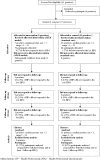The safe environment for every kid model: impact on pediatric primary care professionals
- PMID: 21444590
- PMCID: PMC3387892
- DOI: 10.1542/peds.2010-1845
The safe environment for every kid model: impact on pediatric primary care professionals
Abstract
Objective: To examine whether the Safe Environment for Every Kid (SEEK) model of enhanced primary care would improve the attitudes, knowledge, comfort, competence, and behavior of child health care professionals (HPs) regarding addressing major risk factors for child maltreatment (CM).
Methods: In a cluster randomized controlled trial, 18 private practices were assigned to intervention (SEEK) or control groups. SEEK HPs received training on CM risk factors (eg, maternal depression). The SEEK model included the parent screening questionnaire and the participation of a social worker. SEEK's impact was evaluated in 3 ways: (1) the health professional questionnaire (HPQ), which assessed HPs' attitudes and practice regarding the targeted problems; (2) observations of HPs conducting checkups; and (3) review of children's medical records.
Results: The 102 HPs averaged 45 years of age; 68% were female, and 74% were in suburban practices. Comparing baseline scores with 6-, 18-, and 36-month follow-up data, the HPQ revealed significant (P < .05) improvement in the SEEK group compared with controls on addressing depression (6 months), substance abuse (18 months), intimate partner violence (6 and 18 months), and stress (6, 18, and 36 months), and in their comfort level and perceived competence (both at 6, 18, and 36 months). SEEK HPs screened for targeted problems more often than did controls based on observations 24 months after the initial training and the medical records (P < .001).
Conclusions: The SEEK model led to significant and sustained improvement in several areas. This is a crucial first step in helping HPs address major psychosocial problems that confront many families. SEEK offers a modest yet promising enhancement of primary care.
Figures




References
-
- US Department of Health and Human Services, Administration for Children, Youth, and Families Child Maltreatment, 2009: Reports from the National Child Abuse and Neglect Data Systems. Washington, DC: US Government Printing Office, 2010
-
- Hussey JM, Chang JJ, Kotch JB. Child maltreatment in the United States: prevalence, risk factors, and adolescent health consequences. Pediatrics. 2006;118(3):933–942 - PubMed
-
- American Academy of Pediatrics, Committee on Child Abuse and Neglect and Section on Adoption and Foster Care; Stirling J, Jr; American Academy of Child and Adolescent Psychiatry; Amaya-Jackson L; National Center for Child Traumatic Stress Understanding the behavioral and emotional consequences of child abuse [published correction appears in Pediatrics. 2009;123(1):197]. Pediatrics. 2008;122(3):667–673 - PubMed
-
- Dubowitz H. Preventing child neglect and physical abuse: a role for pediatricians. Pediatr Rev. 2002;23(6):191–196 - PubMed
-
- Dubowitz H, Feigelman S, Lane W, Kim J. Pediatric primary care to help prevent child maltreatment: the Safe Environment for Every Kid (SEEK) Model. Pediatrics. 2009;123(3):858–64 - PubMed

